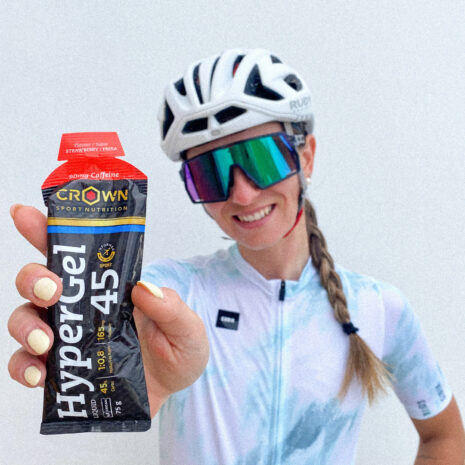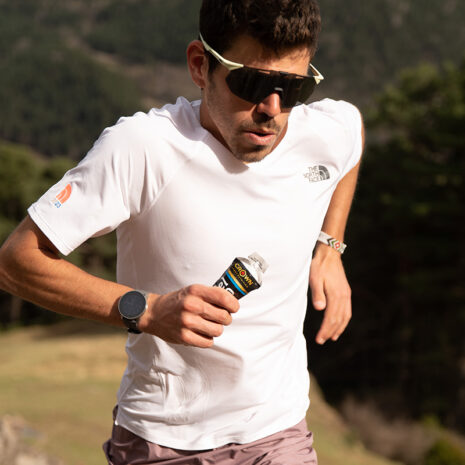HyperGel 45 (1;0,8)
Price range: 3,25€ through 32,49€ VAT included
Energy gel with 45 g of carbohydrates in a 1:0.8 maltodextrin:fructose ratio and 165 mg of sodium (except 400 mg in the salted peanut flavor). Caffeine free and caffeinated versions (80mg). With liquid texture and without sweeteners. Indicated for high carbohydrate intake.
With Informed Sport anti-doping certificate.
- Express shipping to all Europe in 3 to 5 days.
- Free shipping over €49.
- Customer service: Have any questions? Write to us on WhatsApp or email us at clientes@crownsportnutrition.com.

HIGH-CARBOHYDRATE ENERGY GEL WITH EXTRA SODIUM
At Crown Sport Nutrition, we’ve considered athletes who require higher carbohydrate intake during exercise. That’s why we developed the Hyper (1:0.8) range of gels, bars, and drinks. These products allow intakes above 60 g/h of carbohydrates. HyperGel 45 is a high-carbohydrate energy gel with the following features:
- Provides 45 g of carbohydrates
- Maltodextrin and fructose blend in a 1:0.8 ratio
- Extra sodium (165 mg, or 400 mg in Salty Peanut variant)
- Informed-Sport certified
- Mild flavors and pleasant texture
- Maximum absorption and digestibility
- Vegan and allergen-free
HyperGel 45 contains the optimal blend of maltodextrin and fructose in a 1.25:1 ratio (commonly known as 1:0.8), which enhances exogenous carbohydrate oxidation during prolonged exercise (Currell, 2008; Earnest, 2004).
Why combine them in a 1.25:1 (1:0.8) ratio instead of the classic 2:1?
Because this ratio achieves maximum energy efficiency, with 74% of the consumed carbohydrates oxidized for energy (Rowlands, 2015).
Why use maltodextrin as the glucose source?
Maltodextrin ensures higher energetic efficiency compared to alternatives like cyclodextrin or isomaltulose (Palatinose®), and offers better gastrointestinal tolerance due to its lower osmolality and neutral taste (Rowlands, 2022).
With caffeine: certain versions include caffeine, the most effective performance-enhancing ingredient for endurance and strength. It stimulates the central nervous system, delays fatigue, improves muscle contraction, and optimizes fuel use (Grgic, 2019; Lopes, 1983).
Why not use glucose directly?
While glucose and maltodextrin offer similar energetic efficiency, maltodextrin has better osmotic properties and is less sweet, making it more suitable for high doses during exercise.
Summary:
For high-carb sports nutrition, combining maltodextrin and fructose in a 1.25:1 (1:0.8) ratio ensures maximum energy efficiency and minimizes digestive discomfort (Rowlands, 2022).
Sodium is added in the form of sea salt, the key electrolyte lost in sweat and essential for maintaining hydration during exercise (EFSA, 2011).
Ideal texture
Unlike most high-carb gels, HyperGel 45 has a fluid texture that is easy to swallow, without the dense or gritty feel common in other products.
Minimal ingredients
To reduce gastrointestinal distress, the formula uses high-purity ingredients. Neutral flavors contain no added flavorings—just a mild sweetness from fructose. Flavored versions use natural aromas only. No sweeteners or colorants are used.
As with all Crown Sport Nutrition products, HyperGel 45 stands out for its taste, digestibility, and safety, with Informed-Sport anti-doping certification.
Flavors with caffeine: Lemon, Salty Peanut
Flavors without caffeine: Neutral, Strawberry, Mokka
Format: Box of 12 energy gels, 60 ml each
How to use:Depending on individual needs, in terms of carbohydrate intake, a gel can be taken every 20, 30 or 45 minute interval.
Pro Tips:
- To easily exceed 60 g/hr of carbs you can freely combine any of the products in the hyper line: HyperDrink 90, HyperGel 45, HyperBar 45 or HyperGel 30.
*To get to consume those high intakes of carbohydrates, we recommend training your stomach and consulting a sports nutritionist. - For optimal hydration it is necessary to drink at least between 400 and 600 ml during physical activity, either in the form of water or a sports drink such as Isodrink & Energy which also provides mineral salts and extra carbohydrates.
- If the environment is very hot and/or humid: To maintain proper hydration, in addition to the fluid intake mentioned in the previous point, an extra supply of salts is necessary, so it is recommended to ingest approx. 1 capsule of PRO Salt Caps every 60 minutes (1 hour) of physical activity.
Flavors available WITH and WITHOUT Caffeine: Neutral (No flavor added)
Available formats: 75g gels and boxes with 10 gels.
Neutral: Water, maltodextrin, fructose, sea salt (sodium chloride), acidity regulator: citric acid; preservative: potassium sorbate.
Neutral with caffeine: Water, maltodextrin, fructose, sea salt (sodium chloride), (0.1%) caffeine, acidity regulator: citric acid; preservative: potassium sorbate.
Salted Peanut: Water, maltodextrin, fructose, sea salt, flavor, acidity regulator: citric acid; preservative: potassium sorbate.
Lemon: Water, maltodextrin, fructose, sea salt, acidity regulator: citric acid; flavor, preservative: potassium sorbate.
Mokka with caffeine: Water, maltodextrin, fructose, sea salt, flavorings, acidity regulator: citric acid; (0.1%) caffeine, preservative: potassium sorbate.
Strawberry with caffeine: Water, maltodextrin, fructose, sea salt, flavor, acidity regulator: citric acid; (0.1%) caffeine, preservative: potassium sorbate.
You may also like…
-
PACK Hyper Energy Tester 2.0
Original price was: 32,47€.25,00€Current price is: 25,00€. VAT included -
HyperDrink 90, Very high carbohydrate drink
Price range: 3,20€ through 34,90€ VAT included





























